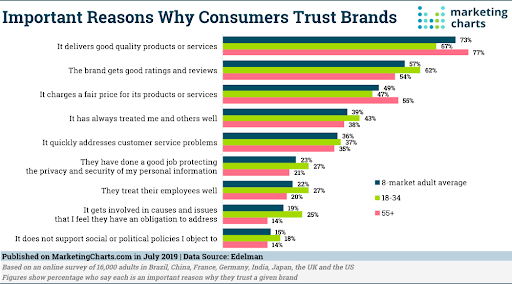The idea to start monetizing digital content appears in the publisher’s life sooner or later, regardless of whether they run a web magazine, news website, or blog. The content is a product today and the chances of earning on it have never been greater.
Publishers have moved their publications from print to digital. It’s partially due to the fact that they are looking for new options both for distribution and monetization of their content. Digital solutions are reducing or totally eliminating printing, effectively cutting production and supply chain costs, giving possibilities to conquer international markets what means global content sharing with saving time and money. A lot of benefits.
You may wonder how it’s possible to monetize digital publication if people are used to consuming content from the Internet for free. However, you should know that it has changed in the last few years. Research shows that readers have been more willing to pay for content lately and this trend is increasing because of the Covid-19 pandemic. This is mainly observed in local news publishing.
This change in people’s approach has also had an influence on the publishers’ situation, opening a lot of content monetization possibilities ahead of them. To start monetizing your content you have to fulfill some conditions and make some preparations.
When can you start to monetize your digital content?
If you start to monetize content too early, you’ll feel disappointed. You have to know that this is a process which demands some preparations. What you should do first is to encourage readers to trust your brand.
We’ve already known that people are able to pay for news – for news they make some kind of bond with, they trust, like, and think as valuable. Only having a solid base of website visitors, newsletter subscribers, or fans of your brand fulfills your monetization success. People have to believe you and your brand because trust is the best currency in the digital world.
Look at the research showing the reasons why consumers trust brands.

Having a group of loyal readers is just the first step. The second one is to find the best way to monetize your content. In this article, you’ll find a few options you have to monetize digital content.
What are the possibilities of digital content monetization?
Your monetization possibilities depend on the type of content you offer, the number of readers you have, and the money you are able to invest in it. You’ll find some of the monetization options below, their short descriptions, and a little suggestion of who this method is for.
1. Direct selling
Content is a product you can sell. What can it be? E-books or PDFs, video series or online courses, tutorials, audiobooks, newsletters, podcast series, and magazine issues. This option is great for… everyone: people preparing courses, authors, magazine publishers, marketers, etc.
Products you offer can be sold in a model “paying once”. For example, you create a PDF guide once and keep selling it for years by making the necessary updates whenever needed. You can also offer subscriptions, which are great for magazine issues, where readers choose the option that is best for themselves (it can be a one month, three months, yearly subscriptions).
For these publishers who publish content in a PDF format, there is an option to have an online bookstore or e-kiosk on their (or their partner’s) website. Thanks to this solution they can publish and sell their content in an easy way like Amen Magazin does it. They offer the sale of a single issue of the magazine as well as the purchase of a subscription.
Who will buy your products? Someone, who knows the value of your publications. Offer people some free content (on the website, in an unpaid newsletter). Only then they can check it’s something for them.
2. Subscriptions and paywalls
A paywall is a strategy to increase revenue based on restricting access to content via a paid subscription. In one word – if you want to read (or read more), you have to pay. It can be implemented on the desktop or in a mobile app. The paywall model has proven effective for news publishers, both for dominating and niche ones. Thanks to their hard work, trustworthiness, and high-quality content, they managed to build up trust among their readers. It’s a simple mechanism. To the audience that is well taken care of, paying for content they love and need comes naturally.
Such is the case of Romania Insider (the English-language website providing content related to Romania). They introduced a paywall to their Android and iOS news app – a user can read one article per month for free and if he wants more, he must pay for full access. Since Romania Insider set up a paywall, the readership statistics remain at a high level.
You can put after paywall all your website and blog content, or part of it. Publishers have a choice between a hard paywall, a soft paywall, and varying degrees in between, like a metered paywall. The revenue growth is a natural effect of the method of restricting access to content. But a long-term profit is to get more subscribers.
3. Advertising
This is the most traditional version of content monetization which moved from print do digital. The traditional, print newspaper business model was based on ad revenues – it was about 80%. The change was in 2014, because of the fall in print advertising (and print publishing altogether) but also the increase in digital subscriptions.
Online advertising is the riskiest form, because of the increasing usage of AdBlock. However, today digital and mobile ads are fit to the content and have a non-distractive form. They are also adjusted to what readers are interested in. You can display ads on your blog, in your videos, and more. There are sports news publishers like the Grand Prix 247 who monetize their content by putting ads in their mobile apps.
Remember, that it’s not a good way for non-popular publishers without money. If you want to make an income from ads on your content, it has to be popular enough that it doesn’t cost you more to drive traffic than you make in ad revenue.
4. Affiliate marketing
The simplest, but also the least profitable method. It sometimes fulfills only a representative function when the goal is to make a brand more popular. If you are thinking about earning seriously, affiliation should be your little additional source to achieve it.
The affiliate programs are good for people without technical skills. The deal is simple. You share information about an external brand with your network using the dedicated referral link. Every person getting through your referral link makes you receive some profits/money from every new deal this external brand gets.
One of the most well-known affiliate marketing programs in the world is The Amazon Associates Program which helps content creators, publishers and bloggers monetize their traffic.
5. Sponsored content
Sponsored content looks like a type of native advertising, however… it’s not an ad. Simply speaking, it’s someone else’s piece of content such as an article or video that lives on your site. You probably guess that in order for someone to post an article on your website and pay you for it, you need to be a big player. This is a method for big brands with a huge audience. Among the large titles offering publishing sponsored articles are Huffington Post and Forbes.
Contrary to many opinions, this method is still alive. There are even platforms (like Accessilly) helping in publishing content on someone else’s website or purchased content on various websites.
6. Membership
Membership isn’t another name for a subscription – it’s a more attractive alternative to it. This method is a way to create a community through audience participation in the publishing business on a deeper level. Readers aren’t only passive receivers of information anymore and memberships enable them to go beyond traditional content consumption.
Members can get a number of exclusive benefits, e.g.: lower ticket prices for events, free conference calls, behind-the-scenes insights, discounts, giveaways, valuable products, etc.
Who should consider membership? This method is doing great when the brand is seen as a trusted source of information and content is highly valuable to the audience (we can see it mainly in B2B sectors or financial markets). For example, the membership method was implemented by the National Journal. They deliver insightful journalism, provide solutions and tools, and identify pathways between policy influencers to help govt affairs professionals navigate DC.
You should remember that building a membership community is a gradual and slow process.
What else?
This is definitely not the end. In the era of technological companies’ domination, the most profitable direction for publishers is to take care of their own distribution and monetization. Thanks to this they won’t share profits with giants. Digital publishing platforms give publishers a lot of possibilities to spread their wings.
Although, you should always remember that successful digital content monetization is an effect of hardworking: building a strong brand, having loyal readers, and continuously promoting a brand.









